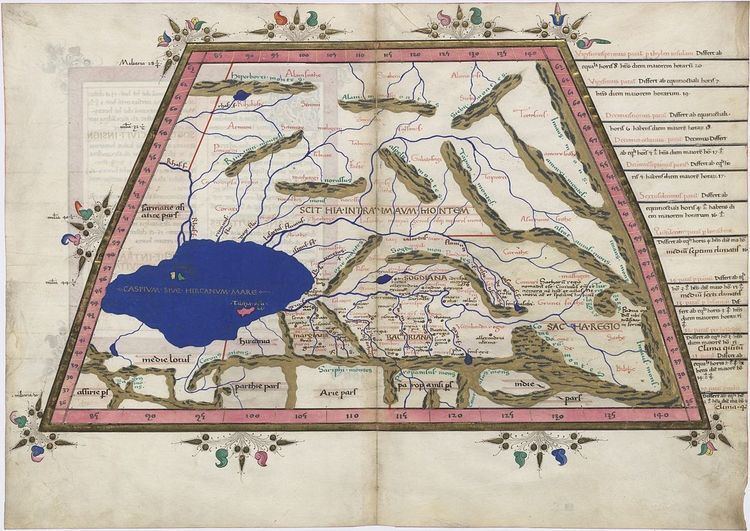 | ||
Native to Sarmatia, Scythia, Sistan, Scythia Minor, Alania Region Central Asia, Eastern Europe Ethnicity Scythians, Sarmatians, and Alans Era Classical antiquity, late antiquity Language family Indo-European
Indo-Iranian
Iranian
Eastern Iranian
Scythian Dialects (Western) Alanian
(Eastern) Scytho-Khotanese | ||
The Scythian languages (/ˈsɪθiən/ or /ˈsɪðiən/) are a group of Eastern Iranian languages of the classical and late antiquity (Middle Iranian) period, spoken in a vast region of Eurasia named Scythia. Except for modern Ossetian, which descends from the Alanian variety, these languages are all considered to be extinct. Modern Eastern Iranian languages such as Wakhi, however, are related to the eastern Scytho-Khotanese dialects attested from the kingdoms of Khotan and Tumshuq in the ancient Tarim Basin, in present-day southern Xinjiang, China.
Contents
- Classification
- History
- Inscriptions
- Personal names
- Herodotus Scythian etymologies
- Herodotus Scythian theonyms
- Pliny the Elder
- Alanian
- Additional literature
- References
The location and extent of Scythia varied by time, but generally it encompassed the part of Eastern Europe east of the Vistula river and much of Central Asia up to the Tarim Basin. The dominant ethnic groups among the Scythians were nomadic pastoralists of Central Asia and the Pontic-Caspian steppe. Fragments of their speech known from inscriptions and words quoted in ancient authors as well as analysis of their names indicate that it was an Indo-European language, more specifically from the Iranian group of Indo-Iranian languages. Alexander Lubotsky summarizes the known linguistic landscape as follows:
Unfortunately, we know next to nothing about the Scythian of that period [Old Iranian] – we have only a couple of personal and tribal names in Greek and Persian sources at our disposal – and cannot even determine with any degree of certainty whether it was a single language.
Classification
The vast majority of Scythological scholars agree in considering the Scythian languages (and Ossetian) as a part of the Eastern Iranian group of languages. This Iranian hypothesis relies principally on the fact that the Greek inscriptions of the Northern Black Sea Coast contain several hundreds of Sarmatian names showing a close affinity to the Ossetian language. The classification of the Iranian languages is in general not however fully resolved, and the Eastern Iranian languages are not shown to form an actual genetic subgroup.
Some scholars detect a division of Scythian into two dialects: a western, more conservative dialect, and an eastern, more innovative one. The Scythian languages may have formed a dialect continuum:
Other East Iranian languages related to the Scythian are Chorasmian and Sogdian.
History
Early Eastern Iranians originated in the Yaz culture (ca. 1500–1100 BC) in Central Asia. The Scythians migrated from Central Asia toward Eastern Europe in the 8th and 7th century BC, occupying today's Southern Russia and Ukraine and the Carpathian Basin and parts of Moldova and Dobruja. They disappeared from history after the Hunnish invasion of Europe in the 5th century AD, and Turkic (Avar, Batsange, etc.) and Slavic peoples probably assimilated most people speaking Scythian. However, in the Caucasus, the Ossetian language belonging to the Scythian linguistic continuum remains in use today, while in Central Asia, some languages belonging to Eastern Iranian group are still spoken, namely Pashto, Pamir languages and Yaghnobi.
Inscriptions
Some scholars ascribe certain inscribed objects found in the Carpathian Basin and in Central Asia to the Scythians, but the interpretation of these inscriptions remains disputed (given that nobody has definitively identified the alphabet or translated the content).
An inscription from Saqqez written in the Hieroglyphic Hittite script may represent Scythian:
King Partitava equates to the Scythian king called Prototyēs in Herodotus (1.103) and known as Par-ta-tu-a in the Assyrian sources. ("Partatua of Sakasene" married the daughter of Esarhaddon c. 675 BC)
The Issyk inscription, found in a Scythian kurgan dating approximately to the 4th century BC, remains undeciphered, but some authorities assume that it represents Scythian.
Personal names
The primary sources for Scythian words remain the Scythian toponyms, tribal names, and numerous personal names in the ancient Greek texts and in the Greek inscriptions found in the Greek colonies on the Northern Black Sea Coast. These names suggest that the Scythian language had close similarities to modern Ossetian.
Some scholars believe that many toponyms and hydronyms of the Russian and Ukrainian steppe have Scythian links. For example, Vasmer associates the name of the river Don with an assumed/reconstructed unattested Scythian word *dānu "water, river", and with Avestan dānu-, Pashto dand and Ossetian don. The river names Don, Donets, Dnieper, Danube, Dniester and lake Donuzlav (the deepest one in Crimea) may also belong with the same word-group.
Herodotus' Scythian etymologies
The Greek historian Herodotus provides another source of Scythian; he reports that the Scythians called the Amazons Oiorpata, and explains the name as a compound of oior, meaning "man", and pata, meaning "to kill" (Hist. 4,110).
- Avestan paiti- "lord", Sanskrit pati-, PIE *poti-, cf. Lat. potestate (i.e. "man-ruler");
- Ossetian maryn "kill", Pashto mrəl, Sanskrit mārayati, PIE *mer- "die" (confusion of Greek Μ and Π);
- Ossetian fædyn "cleave", Sanskrit pātayati "fell", PIE *peth₂- "fall".
Elsewhere Herodotus explains the name of the mythical one-eyed tribe Arimaspoi as a compound of the Scythian words arima, meaning "one", and spu, meaning "eye" (Hist. 4,27).
Herodotus' Scythian theonyms
Herodotus also gives a list of Scythian theonyms (Hist. 4.59):
Pliny the Elder
Pliny the Elder's Natural History (AD 77–79) derives the name of the Caucasus from the Scythian kroy-khasis = ice-shining, white with snow (cf. Greek cryos = ice-cold).
Alanian
The Alanian language as spoken by the Alans from about the 5th to the 11th centuries AD formed a dialect directly descended from the earlier Scytho-Sarmatian languages, and forming in its turn the ancestor of the Ossetian language. Byzantine Greek authors recorded only a few fragments of this language.
